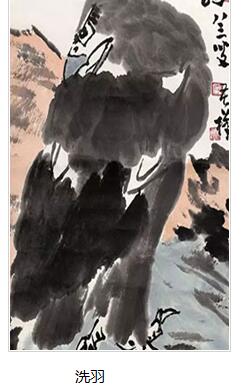一幅好的名人字画,从艺术上来说,主要从三个方面来看:一是名人字画的本身,二是落款,三是印章。下面,大雅堂对这三点印章来讲解一下。
In terms of art, a good painting and calligraphy of celebrities can be seen from three aspects: the first is the celebrity calligraphy and painting itself, the second is the signature, and the third is the seal. Now, the hall will explain the three seals.
自明清以来,印章作为书画的重要组成部分,已成为定式。印章主要分为作者本人的印、题跋人的印章和收藏、鉴赏人的印章三大类。在这些所使用的印章中又分为三个方面:姓名、字号、斋馆、堂号印,闲文、吉语、警句印以及收藏、鉴赏印。
Since Ming and Qing Dynasties, seal, as an important part of calligraphy and painting, has become a fixed pattern. Seals are mainly divided into the author's own seal, the seal of the person who wrote the postscript and the seal of the collector and appreciator. The seals used are divided into three aspects: name, font size, zhaiguan, tanghao, Xianwen, Jiyu, epigram, collection and appreciation seal.
姓名、字号印一般盖在作者名字的下方或左右。斋馆、堂号印一般盖在款字的四周或款字的下方,也有用作迎首,盖在右上角。闲文、吉语、警句印一般盖在书画的左右下角,作为押角,也有用作迎首。收藏、鉴赏印一般盖在书画的左右下角空处,或无碍书画作品本身的空白处,也可以盖在书画以外的装裱上。也有盖在书画较为显着的位置,以示自己的权威,如乾隆、嘉庆皇帝等。
The name and font size are usually stamped below or around the author's name. Zhaiguan and hall number seals are usually placed around or below the characters, and are also used to greet the head and cover the upper right corner. Leiwen, auspicious words and epigrams are usually covered in the lower left and right corners of calligraphy and painting. As a pledge angle, they can also be used to greet the head. The collection and appreciation seal is usually placed on the left and right lower corner of the painting and calligraphy, or the blank space that does not hinder the painting and calligraphy work itself. It can also be covered on the mounting outside the painting and calligraphy. There are also more prominent positions in calligraphy and painting to show their authority, such as Emperor Qianlong and Emperor Jiaqing.
印章作为鉴定书画的一个主要方面,是重视的,因为每幅画上大多有印。凡印章与现在我们定为真迹作品上印章完全一致的,就存在了真迹的可能性。当然这不是惟一的标准,只是鉴定的一个方面从印章鉴别上,会出现所见印章与真迹印章的一些差异。如印文的粗细,边框的宽窄、破损,印迹的清晰与模糊等不同。
Seal as a major aspect of identification of calligraphy and painting, is valued, because most of the paintings have seals. Where the seal is exactly the same as the seal on the work that we have designated as an authentic work, there is the possibility of an authentic work. Of course, this is not the only standard, but only one aspect of identification. From the seal identification, there will be some differences between the seal seen and the original seal. Such as the thickness of the seal, the width of the border, damage, imprint clear and fuzzy.
一幅名人字画作品,其印章也应该具有一定的艺术水平。如果印章很差,则有赝品的可能。印章的艺术水平,主要从书法、章法、刀法上来辨别,特别是文字上不能有错误,一个着名的书画家,是不可能经常出现写错字,用错字的现象。
The seal of a famous calligraphy and painting work should also have a certain artistic level. If the seal is poor, there is a possibility of forgery. The artistic level of seals is mainly distinguished from calligraphy, composition and knife techniques. In particular, there should be no mistakes in the characters. It is impossible for a famous calligrapher and painter to make mistakes in writing and using wrong characters.
鉴别印章还要看印泥的色泽,一幅古画印章的颜色,虽然可能是鲜艳的,但它还会有饱经岁月,历尽沧桑的变化,颜色会变得浑厚而沉着,印泥由朱砂制成,朱砂颜色稳定,但历久的印迹也会发生一些变化,虽然变化很小。黄金性能是稳定的,但新制品的黄金与传世多年的黄金还是会有所不同。所以古代书画上印章的色泽不可能与现代人作品上的印章色泽相同。
Seal identification depends on the color of the inkpad. Although the color of the seal of an ancient painting may be bright, it will have experienced many years and vicissitudes. The color will become thick and calm. The inkpad is made of cinnabar. The color of cinnabar is stable, but the imprint over time will also have some changes, although the change is small. The performance of gold is stable, but the gold of new products will be different from that of gold handed down for many years. Therefore, the color of seal on ancient calligraphy and painting can not be the same as that on modern people's works.
还有一些古书画上的印章,找不到真迹作品上的印迹来参照。这就要从印章的篆刻水平上来分析,是否与书画作品的时代风格相一致,还要从印章的新旧程度和内容上来分析。如果这些方面都没有问题还要从印章以外的各个鉴定方面综合评定,得出结论。
There are also seals on some ancient books and paintings, which can not be referred to by the imprints on the original works. This is to be analyzed from the seal cutting level of the seal, whether it is consistent with the era style of calligraphy and painting works, but also from the old and new degree and content of the seal. If there are no problems in these aspects, we should make a comprehensive evaluation from all aspects except the seal to draw a conclusion.
每个时代的艺术品有每个时代的风格特征,印章也是这样,名人字画上的印章与时代风格相一致,如不这样,必然是赝品。
Each era of art has its own style and characteristics, so does the seal. The seal on celebrity calligraphy and painting is consistent with the style of the times. Otherwise, it must be a forgery.
